The Skypark for Microsoft Flight Simulator – in-depth review of a novel approach

Note: As The Skypark is currently in Early Access, it is worth mentioning that parts of this review might be temporary. As such, this article will be revisited at a later point to account for changes and additions that have been made by Parallel 42. You can read an earlier article with first impressions here.
Catching up
Nowadays, a tablet is considered a pilot’s most versatile companion. It holds information about charts, routes, positions, checklists, company-related information, to name a few. In Microsoft Flight Simulator, we have been lacking this utility aboard our aircraft so far. Being equipped with a tablet, however, does not tackle another challenge that is especially relevant for flight simmers. By having a realistic representation of the world at our fingertips and being able to fly anywhere, numerous choices arise of which a selection can get surprisingly time-consuming.
With their latest addition, Parallel 42 is trying to bridge that gap. Their recently released product The Skypark promises pilots to be challenged with missions by transporting goods or passengers to airports you would likely not fly to otherwise. It is by far no secret though that other free or paid platforms serve this purpose too, the closest being NeoFly. In this review, I wanted to find out if The Skypark is currently worth its price tag. The application is currently available in Early Access, which means that more features are to come in the future (based on user feedback).
The philosophy behind The Skypark is that you are an independent pilot that freely accepts contracts anywhere – using any aircraft. This is an essential difference to similar applications. You do not own aircraft, as in, you do not manage them. Instead, you can take any airplane and select appropriate missions all over the world. The scope of this review reflects my own experience and focuses on the product as if it would be used for all my flights by testing its core, a tablet application called Skypad.
The app experience
My first impression of The Skypark was overly positive. The installation is done via Orbx Central. The program itself is started via The Transponder, a tool that connects to your simulator and updates itself very easily. From there, you start the actual heart of the program: the Skypad.
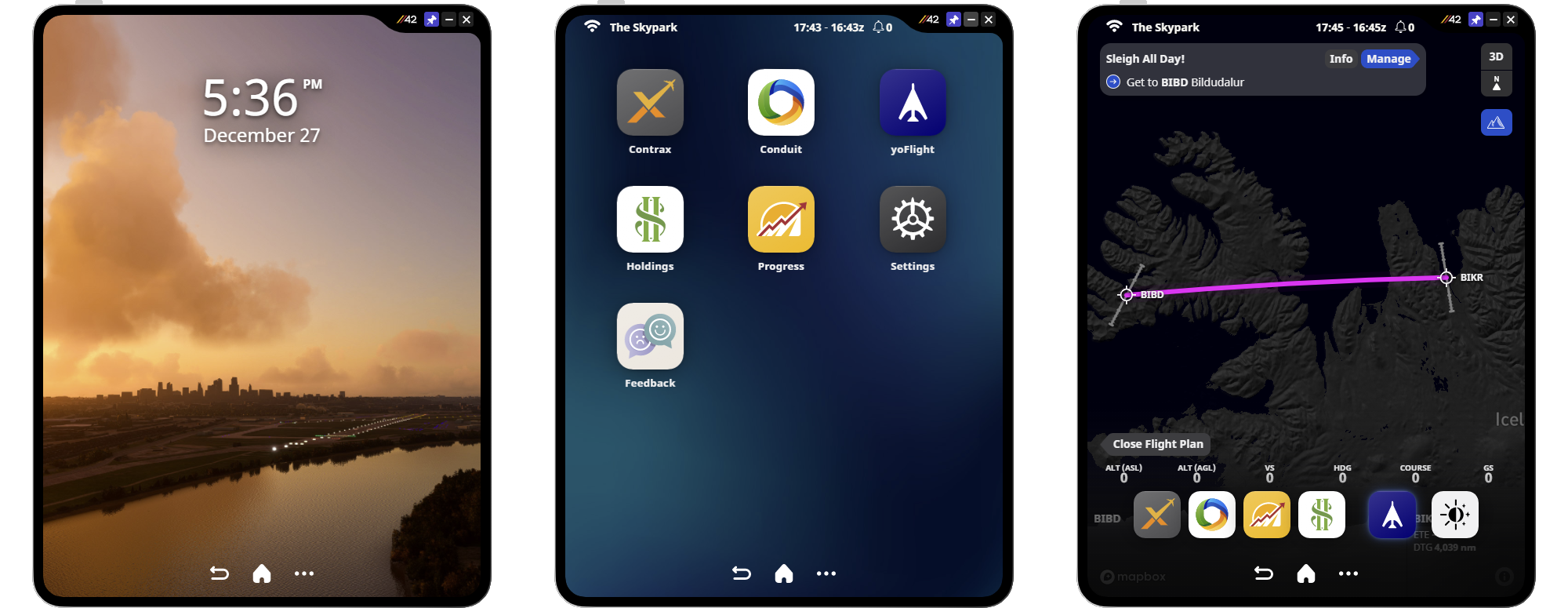
Using a tablet during the flight is a first for Microsoft Flight Simulator. The look-and-feel is very rich. The user interface is appealing, modern, and delivers smooth animations. The simulated gestures are well-conceived. You can drag and scroll through menus, which I found very convenient. Switching between Skypad apps feels natural: there is a home button, a back button, and an app switcher button. The main functionalities of the Skypad that are permanently used in-flight are divided into three apps, which I will describe subsequently.
Possibilities, in style
Before starting your journey of flying anywhere, you need to select a contract that fits your preferences. Contracts can be searched and found in the app Contrax. In there, you accept jobs from any location and do not have to stick to a starting area or a home base. Upon opening Contrax, you are presented with a map view that visualizes routes of various contracts you can choose from. The app features reasonable filters and its smart search field makes finding suitable contracts very user-friendly. For example, you can decide to only search for contracts that are recommended for piston aircraft between 50-100 nm and start or end at KFJK. You can further filter for specific cargo types you want to transport or filter the employer that offers contracts. Passengers are not yet implemented; hence, you transport only cargo.
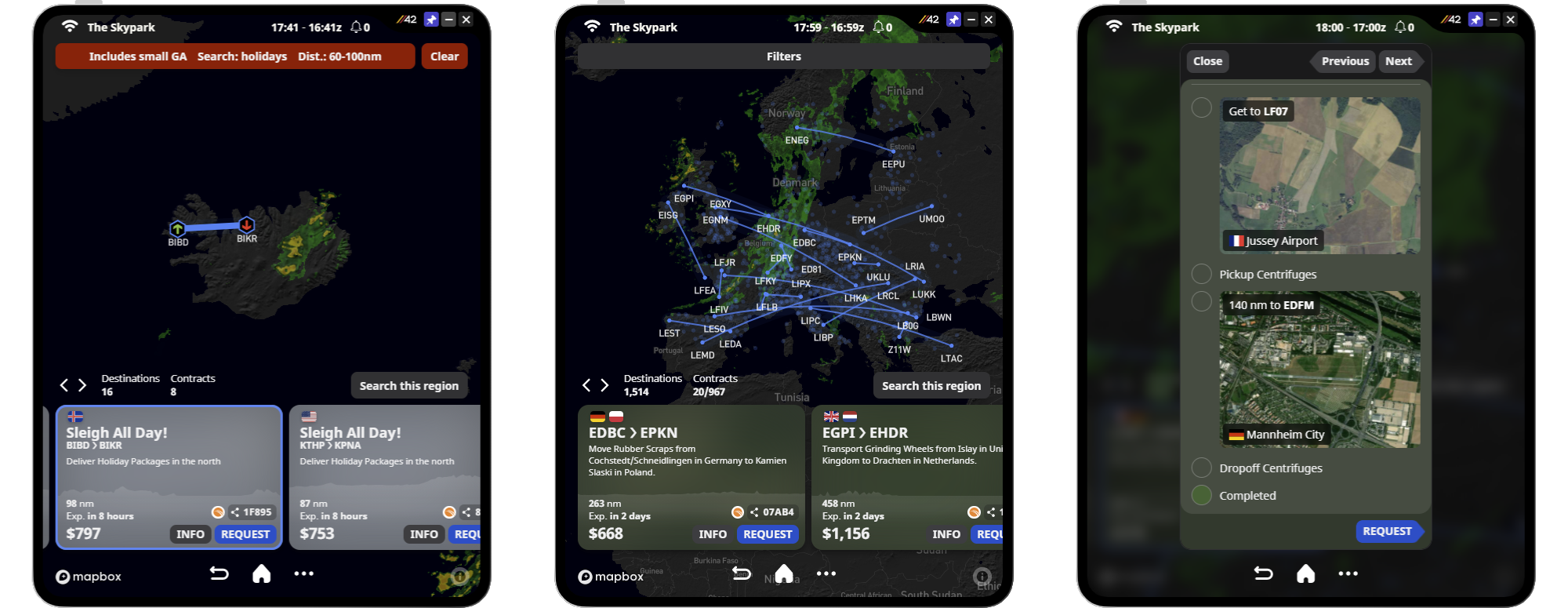
Normal contracts are generated rather randomly. On the other hand, the app offers event-based routes that are handpicked and found with the right keyword. An animated short-term weather visualization is displayed on the map. A nice feature that caught my attention is a visualization of the vertical profile for each contract. When you consider flying a contract, you can get more information about it, i.e., showing the recommended type of aircraft for the route, as well as the expected amount of XP and karma you will receive on completion. Aerial orthophotos of each airport are displayed besides additional information including airport elevation, runways, and runway lengths. Contracts are server-based and expire after some hours. Each contract has a unique code you can share with your friends to be able to fly the same route. However, you cannot interact with each other using The Skypark, instead use the same server in Microsoft Flight Simulator.
Casual flight management
After accepting one or more contracts, their characteristics are transferred and displayed in the Conduit app, where upcoming flights are planned. Mainly, the Conduit app shows a summary of accepted, completed, and failed contracts. For each of them, I am presented with the necessary steps to complete them. The tasks to fulfill a contract are always the same, following a pattern of transport goods X from location A to location B. The currently limited variety of contract types left me wishing for more.
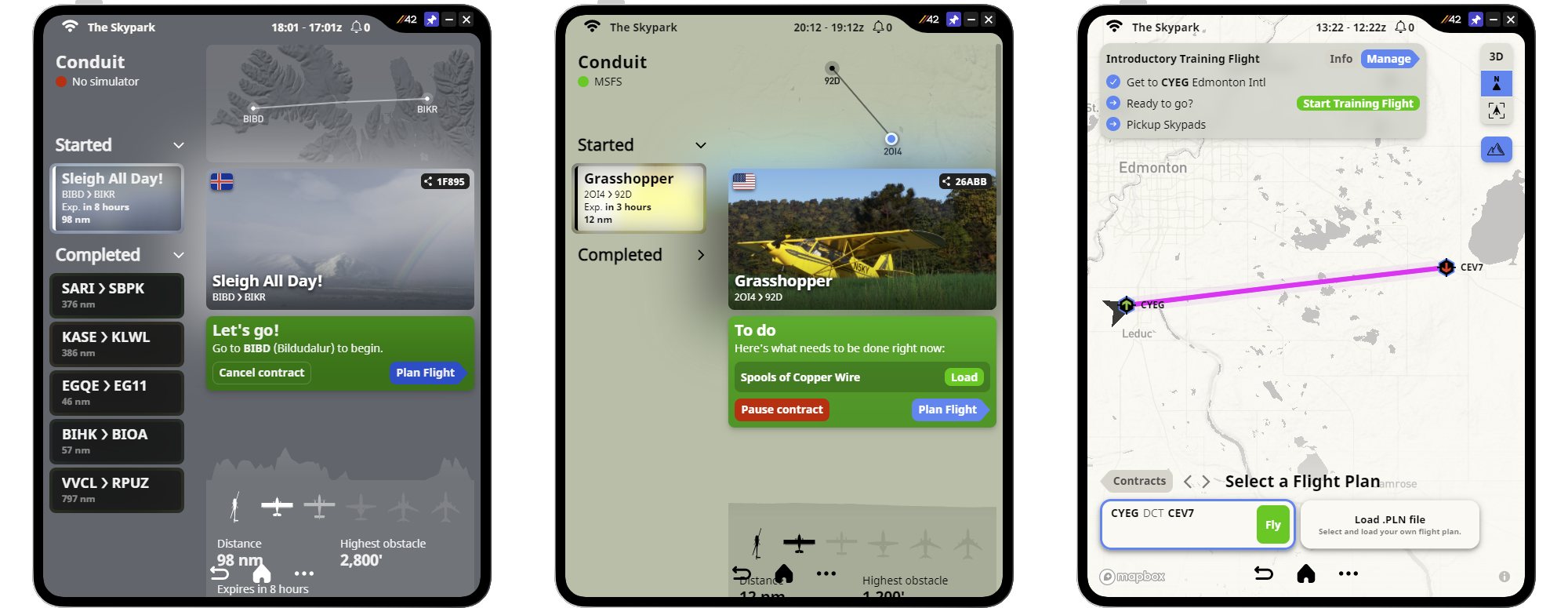
Planning a flight shows an appealing visualization of your route. Routes are by default drawn as direct. In Conduit, your active and recent contracts are displayed and can be viewed on a map that focuses on basic details, such as departure and arrival airport, and the terrain in between. It does not incorporate waypoints, fixes, or whatsoever. Instead, the standard case of completing your contracts is by flying the route directly “as-is” or by importing a flight plan you created beforehand (only .pln files are currently supported). Still, the route of your imported flight plan is correctly shown on the map. Information regarding the vertical profile and the highest obstacle comes in handy. When ready to fly a contract, you get to the location by selecting the respective airport in Microsoft Flight Simulator and load your cargo.
Navigating flights
The actual flying begins at this point. You will be using yoFlight, a flight tracker that displays your position on a pretty map and includes your route and additional info, such as altitude (both in mean sea level and above ground level), your vertical speed, true heading, course, and groundspeed. It also shows your relative position within the vertical profile including an up or down trend, quickly informing you whether you need to go higher for the next obstacle or better descend faster for reaching your target altitude. The map modes include both a 2D and topographical 3D view, automatic zoom, plus you can lock the map on your aircraft. Using the yoFlight app while being in the air is very useful to get familiar with the surroundings in VFR conditions. It also shows extended centerlines for all runways of your departing and arrival airports, allowing you to better line up your approaches. Overall, I found the visualization during the flight top notch. I only missed a visualization of my flight path, as well as an indication that shows my magnetic heading and wind. Alas, the weather visualization of the Contrax app was not present anymore in yoFlight.
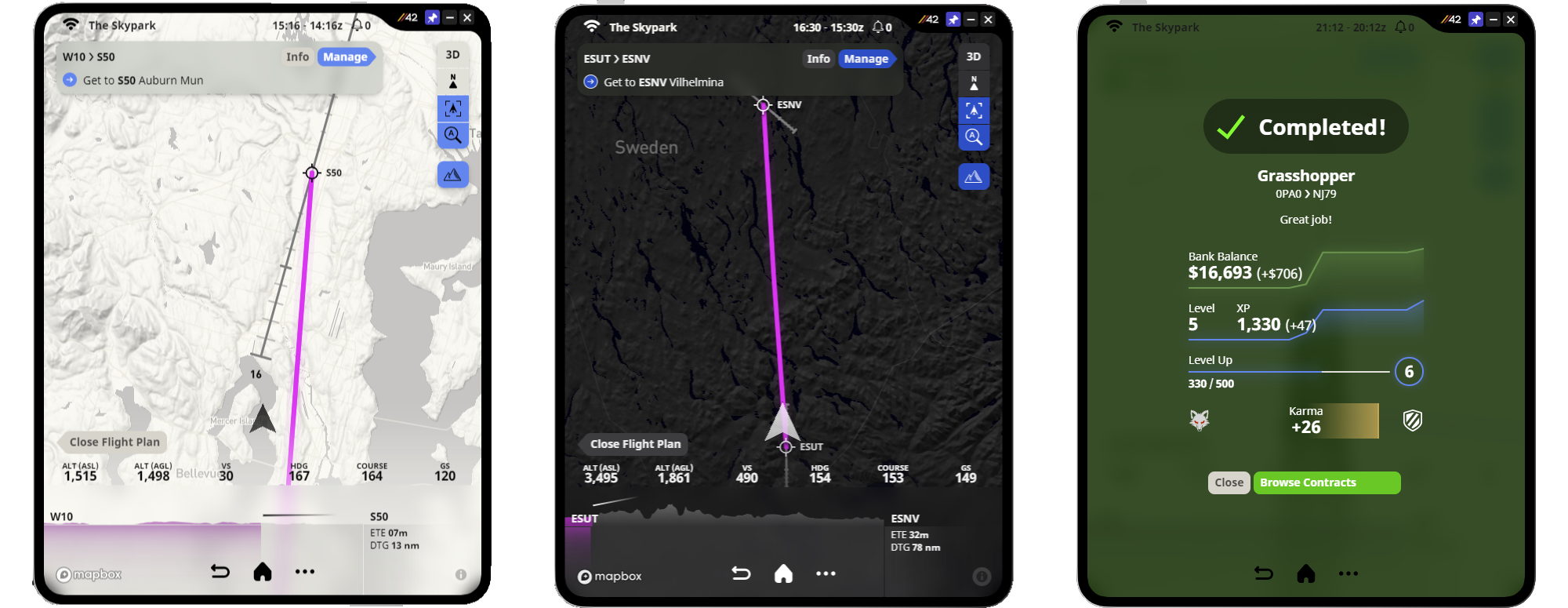
You merely focus on flying contract routes. The rest of any flight is calm. There are no triggered events in-flight for standard contracts. After having landed at your destination, you are informed via in-game messages. Taxiing to the apron or simply stopping the plane anywhere and (instantly) unloading the cargo finishes the contract. After that, a flight summary shows money, XP, as well as karma gains. That completes the cycle of typical contract-based work in The Skypark.
Progression systems
Besides the aforementioned main apps for carrying out your flights, you will find additional apps, which mainly allow keeping track of your progress. Rather unsurprisingly, one of those apps is called Progress. The app shows visualization changes in your bank balance, level, XP, karma, as well as your reliability score. The latter is hidden from you and depends on whether you successfully fulfill contracts and whether you fly them in-time. The only way to reveal your reliability for a limited amount of time is by flying into Kansas City, the location of your dispatching agent. How exactly your reputation score influences the given number of contracts you can select from remains unclear, as inside The Skypark it is currently rather hard to notice a difference in contract specifications as you level up or alter your karma and reliability rating. It is a nice detail though.
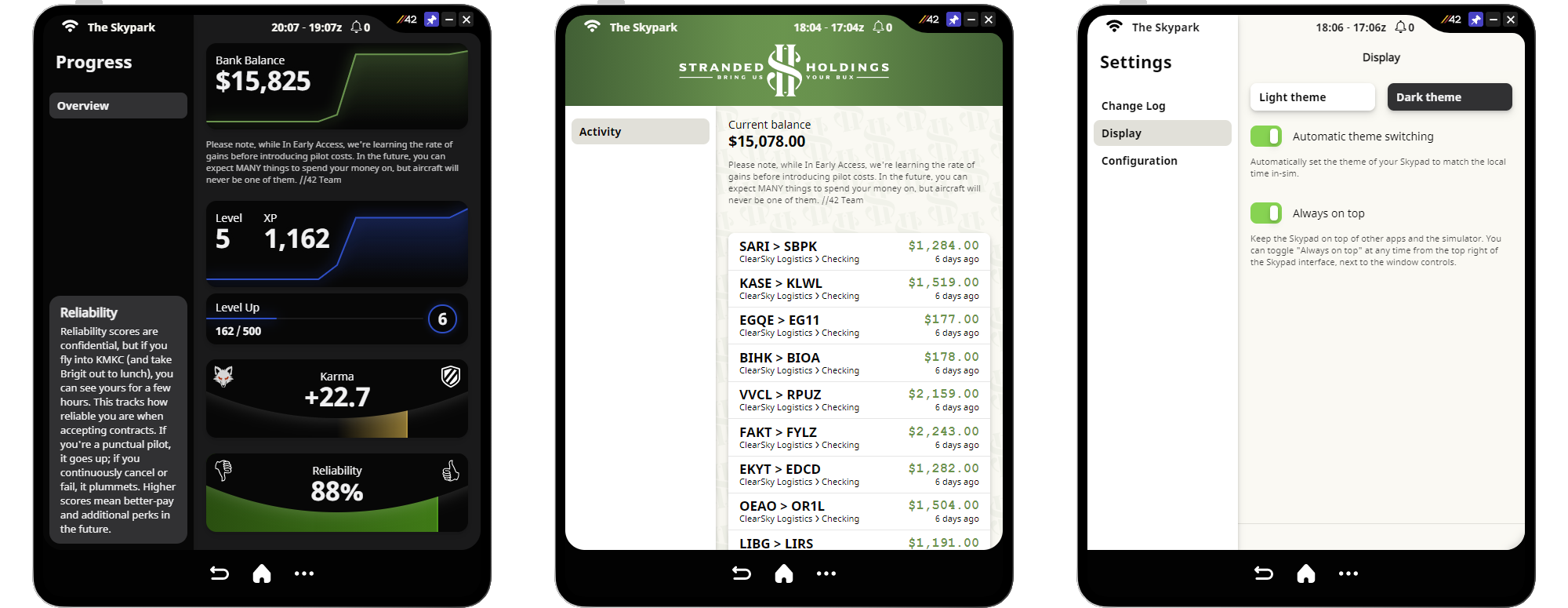
While you have some time again on the ground, you can check your finances in the Holdings app. That is, you scroll through a list of your payouts of past contracts. Currently, you cannot do anything with the money you have earned. This is a major downside. You accumulate XP, karma, and money; however, you are unable to make use of any of them. Certainly, Parallel 42 has recently announced that there will be a vast number of opportunities to spend money on in the future. The Settings app includes features, such as adjusting the theme to your local flight time. It also displays the changelog. The Skypad supports day and night modes that can be changed in the settings app or the app switcher, although switching to night mode in all apps did not always work as expected. Lastly, the Feedback app rounds up the Early Access setting.
The state and the future
Overall, I was positively surprised by the stability of The Skypark. The application only has a few minor bugs. Those are certainly part of the Early Access experience. In terms of support, the developers respond swiftly and are very helpful. So far, they ship updates to the Skypad quickly and constantly introduce small features and event-based contracts. One of The Skypark’s strengths is its usability. The UI design of simulating a modular tablet is a welcoming approach and holds extensible possibilities. It is possible to move the Skypad to another display, e.g., a second screen or a tablet that extends or mirrors your computer screen using specialized software. The application requires a minimum resolution of 1080p or higher and its window is not resizable.
The contracts you can choose from are offered by two major companies. Should you decide to choose the bright side, you only accept offers from Clear Sky, a company representing the ordinary way of obtaining money and karma. Should you however lean towards earning a few more bucks rather easily, you might want to accept the occasionally shown contracts by Coyote, a shady organization offering lucrative possibilities by transporting dubious cargo. Generally speaking, Coyote contracts are financially more rewarding but decrease your karma level. At this stage, however, I could not spot negative implications of accepting Coyote contracts or having bad karma. This leaves room for improvement. As you complete contracts, your karma level mainly decides over the contracts you are served with. That is, you either see mainly those by Clear Sky if your karma is positive or Coyote ones in case you have negative karma. So far, it is solely a question of personal preference.
Contracts differ in their payout levels, such that the ratio between distance and payout can vary slightly. Hence it can also be lucrative to compare contracts. Having no possibility to spend your money on anything limits the experience a lot. As you level up, you can choose from better contracts. However, I could not find a notable difference in payout levels so far. With a progression-based system in place, a summary of new options or perks obtained when leveling up or reaching a certain karma level is a necessary mechanism that I missed. Again, there is currently no variety in contract types.
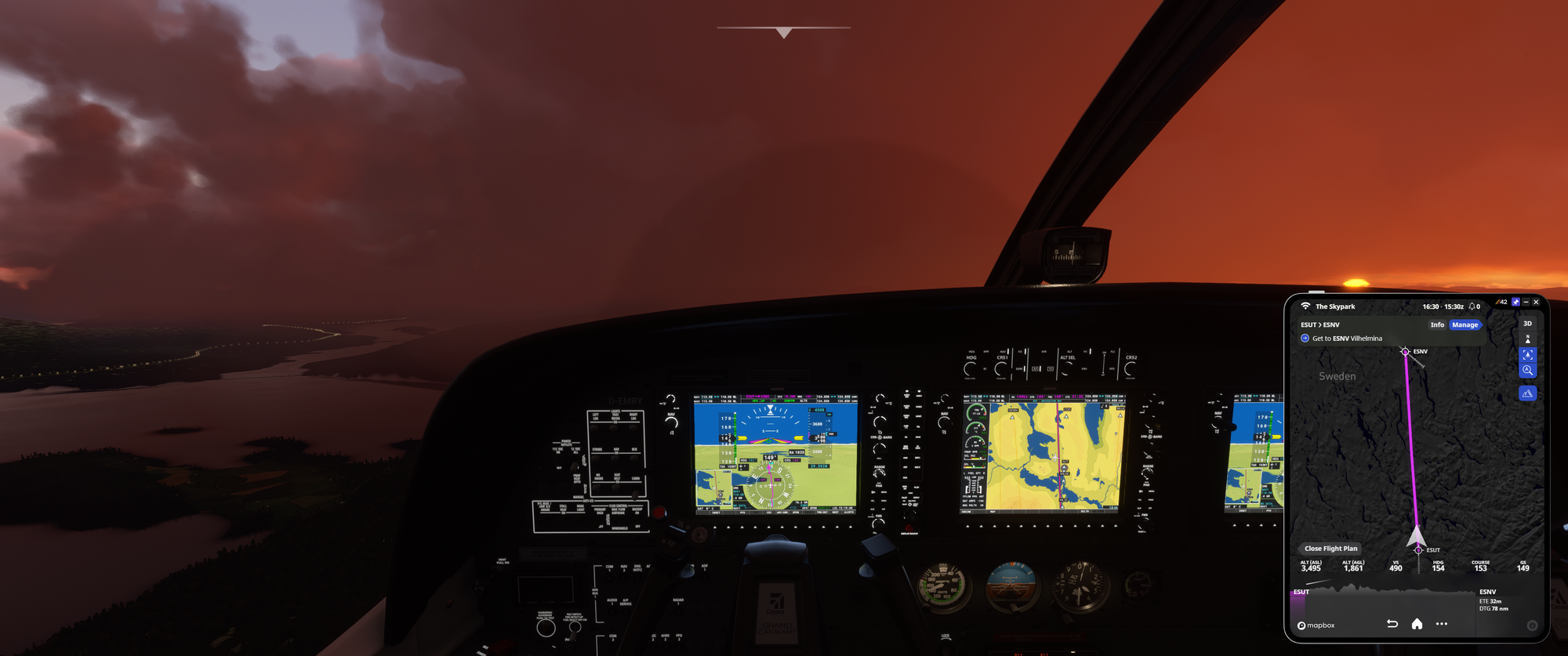
The sound experience in the intro and tutorial flight was very immersive and refreshing. In later flights, as you might be too motivated and rather want to depart quickly, your dispatcher reminds you that you might have forgotten something. There are some more settings (like grasshopper contracts) in which I noticed dedicated voice features. Any standard contract you fulfill from this point follows the same pattern though and only varies in the type of cargo you transport. The sound of loading different cargo types does not vary. With the rich voicings in the beginning, The Skypark is missing some entertainment in the following stages to break ties with monotony and to allow for user interaction. Having said this, a multi-leg flight with voiceovers has already been released.
Many times, simulator crashes are inarguably inevitable. The Skypark anticipates this circumstance by recognizing that if your simulator has stopped working for various reasons, it gives you coordinates to be able to fly again from this point (or in the surrounding area of the coordinates). This prevents having to restart your contracts for reasons that are out of your reach.
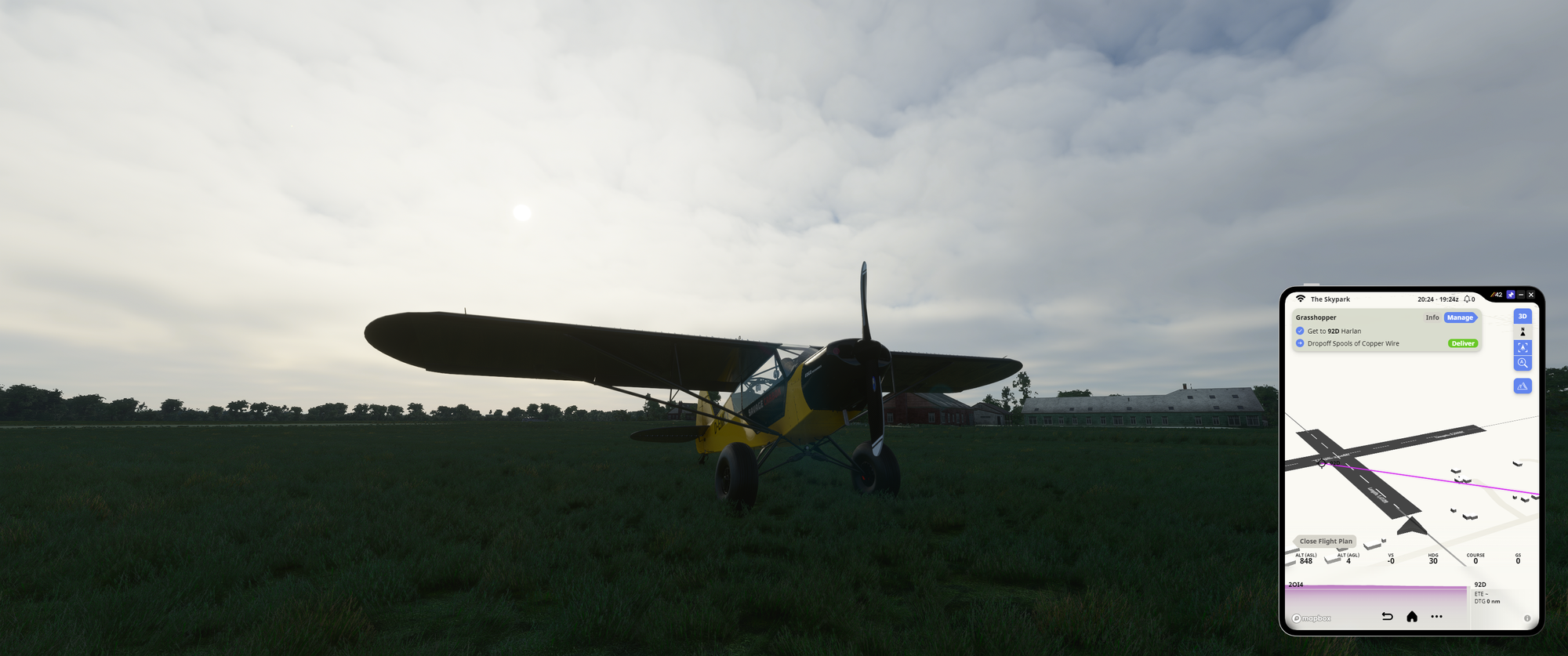
By estimating the platform that The Skypark wants to be, there is a need for various features to get the in-game economy going and to provide pilots with an immersive experience. Compared to its competitors, such features could include an option to display checklists or charts, creating your own route in Skypad by stringing together waypoints, or importing a route via Simbrief. In terms of money spending opportunities, a basic fuel simulation might be a reasonable start. Also, a load simulation that actually alters your takeoff weight and takes some time to load cargo might be an option. Perhaps, players would be able to run companies similar to the existing ones; companies that publish their contracts and reward other players with karma, as well as money by completing them. What is sure is that The Skypark will offer a subscription-based model in the long-term to finance their server infrastructure. Subscribing to their service will unlock additional features (such as a coop mode) that have not been announced in detail yet. It remains to be seen how Parallel 42 manages to balance essential features and integrates advanced ones. The close distance to (the very similar) NeoFly however proves to give users a reasonable choice.
Conclusion
From a current point of view, The Skypark is suitable for pilots who do not want to deal with overly managing their plane, their airline, or the kind of paperwork and logistics on the ground that comes with being an independent contractor. The Skypark does not address every flight simmer – and frankly, it does not have to. It is separating itself from airline managers with enhanced managing complexity, from FSEconomy to OnAir and eventually Air Hauler 2. Pilots that prefer this peculiarity should not get involved here and wait for how the product develops. Yet, it positions itself definitely towards users who prefer a clean user interface that puts you in the seat. Simulation claims excluded.
The Skypark holds great potential in being a comprehensive utility for pilots. The software is surprisingly usable and manages to transmit a strong look-and-feel. Using the tablet in my flights feels more natural than other flight management software. This is why I eventually integrated the Skypad into my flights. Worldwide contracts, events, and complete freedom in how you want to do your jobs are definitely reasons to find your next flight using the Skypad. Given the lack of being able to spend virtual money at this stage of development and no noticeable implications as you make your choices or progress throughout the application, there is low long-term motivation so far. The Skypad mainly acts as a flight companion with a very appealing user interface that indeed gives you a purpose to fly, still lacks a deeper purpose other than accumulating any of the described currencies in-game. At this point in software development, you should mainly purchase The Skypark if you are interested in having an accompanying flight tool and support the development with your ideas.
